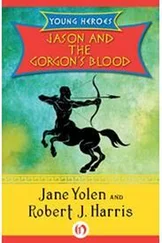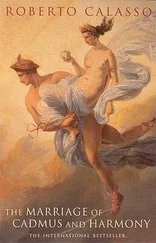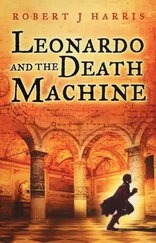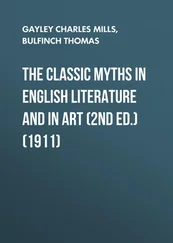Etymologists of ancient times understood  to be that which na
to be that which na  , “does not flow,” with a privative prefix a . And for once modern linguists agree. Including Mayrhofer, who only adds a parallel with the Greek phtheírō , “to corrupt” and “to destroy,” whence áphthartos, unvergänglich , and so the Italian imperituro , or the English “imperishable,” which, from a certain moment on, was to be the dominant if not exclusive meaning of
, “does not flow,” with a privative prefix a . And for once modern linguists agree. Including Mayrhofer, who only adds a parallel with the Greek phtheírō , “to corrupt” and “to destroy,” whence áphthartos, unvergänglich , and so the Italian imperituro , or the English “imperishable,” which, from a certain moment on, was to be the dominant if not exclusive meaning of  .
.
The syllable is that which remains unscathed. When the woman theologian Gārgī challenged Yājñavalkya in the highest and most tense duel of thought of which we have record — and not even the Greece of the sages and sophists produced its like — the stern, brusque seer was asked to name the weft on which different things were woven, for Gārgī was a famous weaver. Eleven times Yājñavalkya answered her, naming the weft of the water, the winds, the atmosphere, the worlds of the Gandharvas, the worlds of the sun, the worlds of the moon, the worlds of the constellations, the worlds of the gods, the worlds of Indra, the worlds of Prajāpati, the worlds of brahman . At which point he in turn challenged Gārgī: “Do not ask too much, take care that your head doesn’t burst.” But Gārgī was fearless, and pressed on. She said: “That which, oh Yājñavalkya, is above the sky, that which is beneath the earth, that which is between the sky and the earth, that which is called past, present, and future, upon what weft is this woven?” Yājñavalkya replied: “On the ether, ākāśa.” But this still wasn’t enough: “‘And the ether, what is that woven on?’ He answered: ‘In truth, oh Gārgī, on this  [on the syllable, on the imperishable], of which the brahmans say that it is neither thick nor thin, neither short nor long, neither flame nor liquid, neither colored nor dark, neither wind nor ether, it doesn’t stick, is without taste, without smell, without eyes, without ears, without voice, without mind, without heat, without breath, without mouth, without measure, without an inside, without an outside. It does not eat and is not eaten.’”
[on the syllable, on the imperishable], of which the brahmans say that it is neither thick nor thin, neither short nor long, neither flame nor liquid, neither colored nor dark, neither wind nor ether, it doesn’t stick, is without taste, without smell, without eyes, without ears, without voice, without mind, without heat, without breath, without mouth, without measure, without an inside, without an outside. It does not eat and is not eaten.’”
Yājñavalkya’s words mark the turning point in the history of the  : from now on this neuter noun that means “syllable” would appear in the texts as an adjective meaning “imperishable,” and thus effacing the “syllable.” But originally the two meanings coincided. How do we know? The
: from now on this neuter noun that means “syllable” would appear in the texts as an adjective meaning “imperishable,” and thus effacing the “syllable.” But originally the two meanings coincided. How do we know? The  tells us: “When the ancient Dawns rose, the Great Syllable [ mahed
tells us: “When the ancient Dawns rose, the Great Syllable [ mahed  m ] was born in the footprint of the Cow.” “Footprint” is a translation of pada , a key word in the enigmatic lexicon of which the
m ] was born in the footprint of the Cow.” “Footprint” is a translation of pada , a key word in the enigmatic lexicon of which the  is woven, and it means “foot,” “paw,” or even “limb, articulation” of a line of verse, and finally “step” or “footprint.” As for the cow, and again drawing on the enigmatic lexicon, this is vāc, Word, Vox . And “vāc is Gāyatrī , because vāc sings [gāyati] and protects [trāyate] all this [universe].” Even as it issues forth, then, the syllable is already meter, as another hymn by enigmas will hint: “The wild Cow lowed as it fashioned the flowing waters; it became of one pada , of two padas , of eight padas , of nine padas , of a thousand syllables in the supreme place. From her flow the seas, on her live the four regions of the world. On the syllable that flows from her [
is woven, and it means “foot,” “paw,” or even “limb, articulation” of a line of verse, and finally “step” or “footprint.” As for the cow, and again drawing on the enigmatic lexicon, this is vāc, Word, Vox . And “vāc is Gāyatrī , because vāc sings [gāyati] and protects [trāyate] all this [universe].” Even as it issues forth, then, the syllable is already meter, as another hymn by enigmas will hint: “The wild Cow lowed as it fashioned the flowing waters; it became of one pada , of two padas , of eight padas , of nine padas , of a thousand syllables in the supreme place. From her flow the seas, on her live the four regions of the world. On the syllable that flows from her [  ] lives all this [universe].” “The nonflowing that flows,”
] lives all this [universe].” “The nonflowing that flows,”  it is on these two words that the enigma converges, as if all the fluidity of life were made possible only by something that doesn’t flow. The syllable is the meeting point between pure vibration and form, the meter.
it is on these two words that the enigma converges, as if all the fluidity of life were made possible only by something that doesn’t flow. The syllable is the meeting point between pure vibration and form, the meter.
The syllable, the meter, the word: the circle expands. But it doesn’t close. For that to happen the syllable must be answered by its counterpart: the fire. The syllable is effective only if spoken before and in counterpoint to the fire. At every kindling of the fire, as the sacrificer rubs the two pieces of wood together, a chant can be heard in the background, the sāman that gives new vigor, while “the hotar holds himself ready to start reciting the appropriate mantras at the first wisp of smoke that will rise from the lower drilling block. When the drilling fails and the smoke disappears, the mantra, too, ceases; to start again when the smoke appears again. One can say that the mantra bears the fire, or that the fire begets the mantra.” Only reciprocal generation — as between  and Virāj, at once goddess and meter — can serve as an account of the relationship between the meters and the fire. Gāyatrī is a robe that wraps and protects from the sharp blades of the flame. But Gāyatrī is also a “firebrand,” samidh: “Gāyatrī, when kindled, kindles the other meters; and once kindled the meters bring the sacrifice to the gods.” It is said of Agni Jātavedas, Fire Knower-of-Creatures, that he sparks within the syllable, in that most arcane of places, which is “the matrix of order,”
and Virāj, at once goddess and meter — can serve as an account of the relationship between the meters and the fire. Gāyatrī is a robe that wraps and protects from the sharp blades of the flame. But Gāyatrī is also a “firebrand,” samidh: “Gāyatrī, when kindled, kindles the other meters; and once kindled the meters bring the sacrifice to the gods.” It is said of Agni Jātavedas, Fire Knower-of-Creatures, that he sparks within the syllable, in that most arcane of places, which is “the matrix of order,”  yónim .
yónim .
Only an intimacy, a mingling, a superimposition as extreme as that between the syllable and the fire can guarantee the continuity of the world for the moment. This is the ultimate enigma behind all the ciphered names: the “imperishable” consists of a sound sustained by a transitory breath and in a devouring blaze that will go out as soon as no fuel is fed to it. The imperishable is what most appears to be ephemeral. The continuous is entrusted to a breath that may run out at any moment and to a flame that an unknown hand must constantly tend. But that is precisely what the rites are for: to weave continuity. Otherwise life would fall apart in broken stumps. Above all this is what the meters are for: to give continuous measure to our breathing. Otherwise how would we know when to take a breath? The Śatapatha  observes: ‘If [the officiant] took a breath halfway through a line, there would be a crack in the sacrifice”: it would be a first defeat at the hands of the discontinuous, which would force its way into the middle of the line like a wedge. To make sure that doesn’t happen, one must at least recite the lines of the Gāyatrī , the shortest of the meters, one by one, without breaking them to take a breath. Thus a tiny, unassailable cell of continuity will be formed in the serrated extension of the discontinuous.
observes: ‘If [the officiant] took a breath halfway through a line, there would be a crack in the sacrifice”: it would be a first defeat at the hands of the discontinuous, which would force its way into the middle of the line like a wedge. To make sure that doesn’t happen, one must at least recite the lines of the Gāyatrī , the shortest of the meters, one by one, without breaking them to take a breath. Thus a tiny, unassailable cell of continuity will be formed in the serrated extension of the discontinuous.
Passing the baton like relay runners, the meters act first and foremost upon time; they make sure that it isn’t interrupted: “Above all he recites the verses in a continuous way: thus he makes the days and nights of the years continuous, and thus the days and nights of the year alternate in a continuous, uninterrupted way. And in this way he leaves no path open to the evil enemy; in fact he would leave one path open, therefore, if he recited the lines jerkily; he recites them smoothly without interruptions.” What emerges quite dramatically here is the Vedic officiant’s overriding anxiety: the fear that time will be broken, that the day’s progress will suddenly be interrupted, that the whole world may be left in a state of irretrievable dispersion. This fear is far more radical than the fear of death. Or rather, the fear of death is a secondary manifestation of it — a modern manifestation, we might say. Something else precedes it: a sense of precarious-ness so extreme, intense, and lacerating as to make the continuity of time appear as an improbable gift forever on the point of being withdrawn. So it is that one must act at once by making the sacrifice, which we can define as that thing which the officiant tends, extends . This weave from an indeterminate material, this first text, which is the sacrifice, must be “tended,” tan , so as to form something connected, something without a tear, or interruption, or break, through which the “evil enemy” who is always ready to strike might creep in; something that, because of the elaborate nature of its composition, can stand up against the world, which presents itself to us as a series of “isolated”  entities, of tears, interruptions, and fragments, in which we recognize shreds of the dismembered body of Prajāpati. To overcome the discontinuous: this is the officiant’s goal. Conquering death is just one of the many consequences of that. So the first requirement is that the
entities, of tears, interruptions, and fragments, in which we recognize shreds of the dismembered body of Prajāpati. To overcome the discontinuous: this is the officiant’s goal. Conquering death is just one of the many consequences of that. So the first requirement is that the  voice be, so far as is possible, tense, a constant issuing of sound. That is how one day the Gāyatrī meter became Gāyatrī the bird and had the power to soar up to the heavens to conquer Soma, that intoxicating and encompassing liquid which the officiant recognized as the supreme expansion of the continuous.
voice be, so far as is possible, tense, a constant issuing of sound. That is how one day the Gāyatrī meter became Gāyatrī the bird and had the power to soar up to the heavens to conquer Soma, that intoxicating and encompassing liquid which the officiant recognized as the supreme expansion of the continuous.
Читать дальше
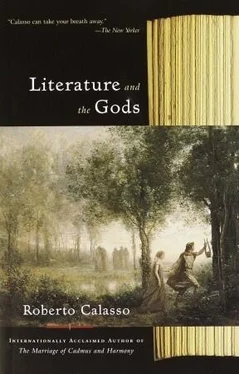
 to be that which na
to be that which na  , “does not flow,” with a privative prefix a . And for once modern linguists agree. Including Mayrhofer, who only adds a parallel with the Greek phtheírō , “to corrupt” and “to destroy,” whence áphthartos, unvergänglich , and so the Italian imperituro , or the English “imperishable,” which, from a certain moment on, was to be the dominant if not exclusive meaning of
, “does not flow,” with a privative prefix a . And for once modern linguists agree. Including Mayrhofer, who only adds a parallel with the Greek phtheírō , “to corrupt” and “to destroy,” whence áphthartos, unvergänglich , and so the Italian imperituro , or the English “imperishable,” which, from a certain moment on, was to be the dominant if not exclusive meaning of  .
. [on the syllable, on the imperishable], of which the brahmans say that it is neither thick nor thin, neither short nor long, neither flame nor liquid, neither colored nor dark, neither wind nor ether, it doesn’t stick, is without taste, without smell, without eyes, without ears, without voice, without mind, without heat, without breath, without mouth, without measure, without an inside, without an outside. It does not eat and is not eaten.’”
[on the syllable, on the imperishable], of which the brahmans say that it is neither thick nor thin, neither short nor long, neither flame nor liquid, neither colored nor dark, neither wind nor ether, it doesn’t stick, is without taste, without smell, without eyes, without ears, without voice, without mind, without heat, without breath, without mouth, without measure, without an inside, without an outside. It does not eat and is not eaten.’” : from now on this neuter noun that means “syllable” would appear in the texts as an adjective meaning “imperishable,” and thus effacing the “syllable.” But originally the two meanings coincided. How do we know? The
: from now on this neuter noun that means “syllable” would appear in the texts as an adjective meaning “imperishable,” and thus effacing the “syllable.” But originally the two meanings coincided. How do we know? The  tells us: “When the ancient Dawns rose, the Great Syllable [ mahed
tells us: “When the ancient Dawns rose, the Great Syllable [ mahed  m ] was born in the footprint of the Cow.” “Footprint” is a translation of pada , a key word in the enigmatic lexicon of which the
m ] was born in the footprint of the Cow.” “Footprint” is a translation of pada , a key word in the enigmatic lexicon of which the  is woven, and it means “foot,” “paw,” or even “limb, articulation” of a line of verse, and finally “step” or “footprint.” As for the cow, and again drawing on the enigmatic lexicon, this is vāc, Word, Vox . And “vāc is Gāyatrī , because vāc sings [gāyati] and protects [trāyate] all this [universe].” Even as it issues forth, then, the syllable is already meter, as another hymn by enigmas will hint: “The wild Cow lowed as it fashioned the flowing waters; it became of one pada , of two padas , of eight padas , of nine padas , of a thousand syllables in the supreme place. From her flow the seas, on her live the four regions of the world. On the syllable that flows from her [
is woven, and it means “foot,” “paw,” or even “limb, articulation” of a line of verse, and finally “step” or “footprint.” As for the cow, and again drawing on the enigmatic lexicon, this is vāc, Word, Vox . And “vāc is Gāyatrī , because vāc sings [gāyati] and protects [trāyate] all this [universe].” Even as it issues forth, then, the syllable is already meter, as another hymn by enigmas will hint: “The wild Cow lowed as it fashioned the flowing waters; it became of one pada , of two padas , of eight padas , of nine padas , of a thousand syllables in the supreme place. From her flow the seas, on her live the four regions of the world. On the syllable that flows from her [  ] lives all this [universe].” “The nonflowing that flows,”
] lives all this [universe].” “The nonflowing that flows,”  it is on these two words that the enigma converges, as if all the fluidity of life were made possible only by something that doesn’t flow. The syllable is the meeting point between pure vibration and form, the meter.
it is on these two words that the enigma converges, as if all the fluidity of life were made possible only by something that doesn’t flow. The syllable is the meeting point between pure vibration and form, the meter. and Virāj, at once goddess and meter — can serve as an account of the relationship between the meters and the fire. Gāyatrī is a robe that wraps and protects from the sharp blades of the flame. But Gāyatrī is also a “firebrand,” samidh: “Gāyatrī, when kindled, kindles the other meters; and once kindled the meters bring the sacrifice to the gods.” It is said of Agni Jātavedas, Fire Knower-of-Creatures, that he sparks within the syllable, in that most arcane of places, which is “the matrix of order,”
and Virāj, at once goddess and meter — can serve as an account of the relationship between the meters and the fire. Gāyatrī is a robe that wraps and protects from the sharp blades of the flame. But Gāyatrī is also a “firebrand,” samidh: “Gāyatrī, when kindled, kindles the other meters; and once kindled the meters bring the sacrifice to the gods.” It is said of Agni Jātavedas, Fire Knower-of-Creatures, that he sparks within the syllable, in that most arcane of places, which is “the matrix of order,”  yónim .
yónim . observes: ‘If [the officiant] took a breath halfway through a line, there would be a crack in the sacrifice”: it would be a first defeat at the hands of the discontinuous, which would force its way into the middle of the line like a wedge. To make sure that doesn’t happen, one must at least recite the lines of the Gāyatrī , the shortest of the meters, one by one, without breaking them to take a breath. Thus a tiny, unassailable cell of continuity will be formed in the serrated extension of the discontinuous.
observes: ‘If [the officiant] took a breath halfway through a line, there would be a crack in the sacrifice”: it would be a first defeat at the hands of the discontinuous, which would force its way into the middle of the line like a wedge. To make sure that doesn’t happen, one must at least recite the lines of the Gāyatrī , the shortest of the meters, one by one, without breaking them to take a breath. Thus a tiny, unassailable cell of continuity will be formed in the serrated extension of the discontinuous. entities, of tears, interruptions, and fragments, in which we recognize shreds of the dismembered body of Prajāpati. To overcome the discontinuous: this is the officiant’s goal. Conquering death is just one of the many consequences of that. So the first requirement is that the
entities, of tears, interruptions, and fragments, in which we recognize shreds of the dismembered body of Prajāpati. To overcome the discontinuous: this is the officiant’s goal. Conquering death is just one of the many consequences of that. So the first requirement is that the  voice be, so far as is possible, tense, a constant issuing of sound. That is how one day the Gāyatrī meter became Gāyatrī the bird and had the power to soar up to the heavens to conquer Soma, that intoxicating and encompassing liquid which the officiant recognized as the supreme expansion of the continuous.
voice be, so far as is possible, tense, a constant issuing of sound. That is how one day the Gāyatrī meter became Gāyatrī the bird and had the power to soar up to the heavens to conquer Soma, that intoxicating and encompassing liquid which the officiant recognized as the supreme expansion of the continuous.

